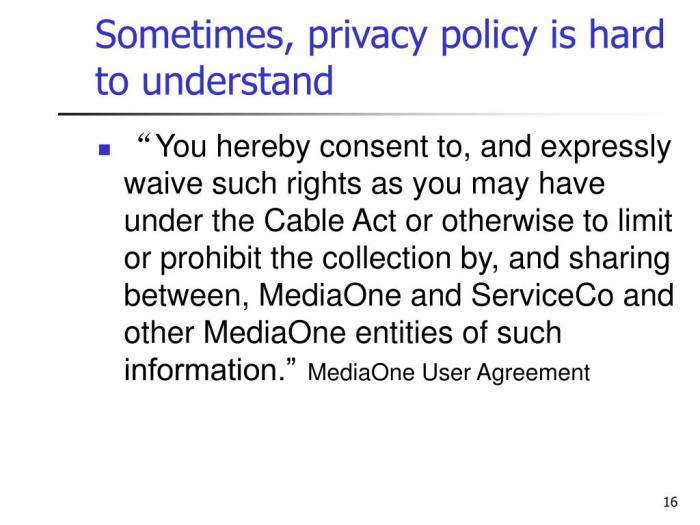
Internet privacy self regulation on shaky ground – Internet privacy self-regulation on shaky ground is a critical issue in today’s digital world. The rapid evolution of online services and technologies has outpaced the development of robust government regulations, creating a void that self-regulation aims to fill. However, this system faces significant limitations, especially when considering the competing interests of users, companies, and governments.
This exploration delves into the historical context, highlighting the shift from government-led to user-centric approaches. It examines the inherent weaknesses of self-regulatory mechanisms, contrasting them with formal legal frameworks and exploring case studies where self-regulation fell short. Furthermore, the role of user awareness, technological advancements, and the interplay of legal and ethical considerations are all dissected, culminating in a discussion of potential future solutions.
The Evolving Landscape of Online Privacy
The digital age has irrevocably altered how we interact, communicate, and conduct business. This shift has brought unprecedented opportunities but also raises profound questions about our personal data and the right to privacy in this online realm. This evolution requires constant vigilance and adaptation, as the lines between the physical and digital worlds continue to blur.The historical development of internet privacy regulations has been marked by a slow, incremental approach, often reacting to emerging threats rather than proactively shaping the online environment.
Early regulations focused on specific areas like intellectual property and fraud, with privacy considerations often treated as secondary concerns. Over time, however, the increasing volume and sensitivity of personal data online necessitated a more comprehensive approach.
Historical Development of Internet Privacy Regulations
Early internet regulations primarily addressed issues like spam and cybercrime, not explicitly focusing on individual privacy. As the internet’s role expanded, governments began to recognize the need for comprehensive privacy protections. This shift was driven by concerns about data breaches, misuse of personal information, and the potential for surveillance. Different jurisdictions have adopted various approaches, with some emphasizing user consent and data minimization, while others prioritize industry self-regulation.
The Shift from Government-Led to User-Led Approaches
The initial approach to online privacy was largely government-driven, with laws and regulations established to protect users. However, the complexity and rapid evolution of technology have led to a more nuanced and user-led approach. This shift emphasizes user empowerment, allowing individuals more control over their personal data through tools like privacy settings and data portability options.
Emerging Privacy Concerns in the Digital Age
The digital age presents a range of new privacy concerns. Facial recognition technology, data mining practices, and the proliferation of interconnected devices are raising anxieties about surveillance and data aggregation. Concerns about the use of AI in decision-making processes, particularly in areas like loan applications and hiring, are also prominent. Targeted advertising and the potential for manipulation based on personal data further highlight the need for robust privacy protections.
Comparison of Privacy Models
Different privacy models address the complexities of data collection and use. These models are designed to balance the interests of users and organizations, reflecting differing perspectives on data control and user rights.
| Privacy Model | Description | Example |
|---|---|---|
| Opt-in | Users explicitly consent to the collection and use of their data. | A website requiring users to check a box to receive marketing emails. |
| Opt-out | Data is collected by default, and users must actively opt out to prevent its use. | Pre-checked boxes on forms indicating consent to data collection. |
| Privacy by Design | Privacy considerations are incorporated into the design and development process of products and services. | A social media platform with strong data encryption and user controls. |
The Role of Technology in Shaping Privacy Expectations, Internet privacy self regulation on shaky ground
Technology plays a pivotal role in shaping privacy expectations. The availability of sophisticated tools for data encryption, data minimization, and user control empowers individuals to take a more active role in protecting their personal information. However, the same technological advancements also create new avenues for data collection and analysis, requiring a constant evolution of privacy safeguards. Sophisticated AI algorithms and the rise of the Internet of Things (IoT) highlight the need for continuous adaptation to the evolving technological landscape.
The ability to personalize experiences and services, such as targeted advertisements or customized recommendations, relies on data collection and analysis, but raises ethical questions about data privacy and potential misuse.
The Limitations of Self-Regulation
Self-regulation in the online privacy sphere, while offering a potentially flexible alternative to formal laws, faces significant limitations. The voluntary nature of these frameworks often makes enforcement challenging, and the lack of a unified standard can lead to inconsistencies and gaps in protection. This leaves users vulnerable to data breaches and privacy violations, particularly in the absence of strong, independent oversight.Self-regulatory mechanisms, relying on industry best practices and codes of conduct, aim to provide a framework for online privacy.
However, their effectiveness is often hampered by inherent weaknesses that limit their ability to provide robust user protection. These weaknesses manifest in various ways, from the difficulty in enforcing compliance to the potential for conflicts of interest among stakeholders.
Inherent Weaknesses of Self-Regulatory Mechanisms
Self-regulation, by its nature, lacks the coercive power of formal legal frameworks. Companies may choose to adhere to voluntary standards for public relations or to enhance their brand image, but they are not legally obligated to do so. This absence of mandatory compliance can create a significant hurdle for achieving widespread adoption and consistent enforcement. Furthermore, the sheer complexity of the internet and the rapid pace of technological advancement can make it difficult for self-regulatory bodies to keep pace, potentially leading to outdated standards and inadequate protections.
Challenges in Enforcing Voluntary Privacy Standards
Enforcing voluntary privacy standards presents significant challenges. Without a formal legal structure backed by sanctions, there is little recourse for users whose privacy rights are violated. Even if a company commits to a certain standard, there’s no independent body to verify its adherence or impose penalties for non-compliance. This lack of accountability is a crucial weakness of self-regulation, which can leave consumers vulnerable to exploitation.
The enforcement process often relies on industry self-reporting, internal audits, or external audits by third-party organizations. However, the lack of stringent verification and punitive measures can make it difficult to ensure genuine compliance.
Comparison of Self-Regulation and Formal Legal Frameworks
Self-regulation differs significantly from formal legal frameworks in its enforcement mechanisms. Formal laws are backed by the power of the state, enabling mandatory compliance and providing recourse for violations. Self-regulatory mechanisms, on the other hand, rely on voluntary compliance and industry best practices. This inherent difference impacts the ability to ensure consistent and comprehensive protection for users.
Formal legal frameworks often provide a more comprehensive and consistent approach to user protection. For example, data breach notification laws, established through formal legislation, require companies to disclose breaches to affected users, while self-regulatory bodies may not have similar enforcement power.
Examples of Self-Regulation Failures
Numerous cases highlight the limitations of self-regulation in protecting user data. A company may establish a robust privacy policy, but its implementation and enforcement might be inadequate. In some instances, companies may have even used self-regulation as a means to delay or avoid stronger legal frameworks. This illustrates a crucial limitation of relying solely on self-regulation to address complex privacy issues.
For example, the lack of a comprehensive, universally accepted standard for data minimization, or the inconsistent application of data retention policies, can lead to unnecessary data collection and storage.
Internet privacy self-regulation seems pretty shaky these days, right? Companies promising better control over our online data often fall short. Meanwhile, innovative tech like Phoenix’s new web surfing features for PCs, detailed in this article on phoenix to give pcs a web surfing makeover , raises questions about how we can even trust these systems to respect our privacy.
This all highlights the precarious nature of self-regulation in the digital age.
Stakeholders in Online Privacy Self-Regulation
| Stakeholder | Role |
|---|---|
| Companies | Develop and implement privacy policies, participate in industry standards, and respond to user concerns. |
| Industry Associations | Promote and develop industry standards and best practices. |
| Users | Comply with privacy policies, report violations, and advocate for their rights. |
| Government Agencies | Monitor industry practices, provide guidance, and potentially enforce self-regulatory frameworks. |
| Third-Party Auditors | Assess compliance with self-regulatory standards and provide independent verification. |
This table Artikels the key stakeholders involved in the process of online privacy self-regulation, illustrating the intricate web of actors involved in upholding privacy standards. The varying roles and responsibilities of these stakeholders highlight the challenges in ensuring accountability and consistency.
The Role of User Awareness and Empowerment
The digital age has brought unprecedented access to information and opportunities, but it has also created complex challenges related to online privacy. Users are constantly bombarded with data collection practices, often without fully understanding the implications. Empowering users with the knowledge and tools to navigate this landscape is crucial for maintaining control over their personal data and promoting responsible online behavior.User awareness is paramount to effective self-regulation of online privacy.
A lack of understanding about how data is collected, used, and shared can lead to inadvertent risks and vulnerabilities. Equipping users with the knowledge necessary to make informed decisions is the first step toward protecting their privacy online.
Importance of User Education
Educating users about privacy policies and practices is essential for promoting responsible data management. Clear and concise explanations of how data is collected, processed, and utilized are crucial. Users need to understand the potential risks and benefits associated with different online activities and the implications of their choices. Education should focus on empowering users to make informed decisions about sharing their personal information, rather than simply imposing restrictions.
Methods for Enhancing User Understanding of Privacy Policies
Simplifying complex privacy policies is vital for user comprehension. Using plain language, avoiding technical jargon, and presenting information in a user-friendly format can significantly improve understanding. Interactive tools, such as interactive infographics and videos, can effectively illustrate the complexities of data handling processes. Moreover, incorporating real-world examples and scenarios can demonstrate the practical application of privacy policies.
Visual aids and examples are more impactful than just textual descriptions.
Significance of User Choice and Control over Personal Data
Users should have meaningful choices regarding their personal data. This includes the ability to opt-in or opt-out of data collection, access and modify their data, and understand how their data is being used. Transparency is key; users should be able to easily understand how their data is being used and by whom. This transparency fosters trust and empowers users to make informed decisions about their data.
Internet privacy self-regulation is definitely on shaky ground these days. It’s hard to feel secure when companies are constantly collecting and sharing data. However, the recent success of AOL’s German service, which has reportedly drawn one million subscribers ( aols german service draws one million subscribers ), suggests a surprising level of user trust in a digital world that often feels like a data minefield.
This raises questions about whether a more robust model of user control and transparency might be needed to restore faith in internet privacy self-regulation.
Tools and Resources for Managing Online Privacy
User control over their online privacy necessitates access to effective tools and resources. These tools can assist users in managing their online profiles, preferences, and data usage.
| Tool/Resource | Description | Example |
|---|---|---|
| Privacy settings on social media platforms | Allow users to control who can see their posts, messages, and other information. | Adjusting privacy settings on Facebook to limit who can see your posts to friends only. |
| Data breach notification services | Alert users to potential data breaches and help them take protective measures. | Signing up for a service that sends alerts if your email address or other personal data is compromised. |
| Privacy-focused browsers | Provide enhanced privacy features like blocking trackers and cookies. | Using a browser like Firefox with built-in privacy enhancements. |
| VPN services | Encrypt online traffic and mask IP addresses, enhancing anonymity. | Utilizing a VPN to browse the internet while protecting your online activity from being tracked. |
| Data anonymization tools | Remove or modify identifying information from personal data. | Using a tool to remove personally identifiable information from a dataset. |
Impact of User Activism on Privacy Standards
User activism plays a significant role in shaping online privacy standards. Public awareness campaigns, advocacy groups, and user-driven initiatives can pressure organizations to adopt more robust privacy policies and practices. Successful campaigns can influence government regulations and industry best practices. Furthermore, user-driven legal actions and public pressure can lead to improved data protection standards.
The Influence of Technological Advancements: Internet Privacy Self Regulation On Shaky Ground

The rapid pace of technological advancement is profoundly reshaping the online landscape, presenting both opportunities and challenges for internet privacy. New technologies are constantly evolving, impacting how data is collected, stored, and used, sometimes in ways that are opaque or even harmful to individual privacy. Understanding these evolving dynamics is crucial for navigating the complexities of the digital world.The proliferation of interconnected devices, the rise of artificial intelligence, and the ever-increasing capacity for data analysis are fundamentally altering the ways in which we interact with the internet.
These advancements have implications for the security and protection of our personal information, requiring careful consideration and proactive measures to mitigate potential risks.
Impact of Artificial Intelligence
Artificial intelligence (AI) is rapidly transforming various sectors, including data analysis and personalized services. AI systems are capable of processing vast amounts of data, enabling unprecedented levels of personalization and efficiency. However, this capability also raises significant privacy concerns. AI algorithms trained on user data can inadvertently reveal sensitive information or create biased profiles, potentially leading to discrimination or unfair treatment.
Moreover, the lack of transparency in some AI systems can obscure the mechanisms by which decisions are made, making it difficult to identify and rectify potential biases or privacy violations.
Big Data Analytics and Privacy
Big data analytics, with its capacity to uncover patterns and insights from massive datasets, presents a double-edged sword. The potential for extracting valuable information and insights from data is undeniable. However, the ethical and privacy implications of analyzing vast quantities of personal information cannot be ignored. Data breaches, misuse of data, and the potential for discriminatory profiling are serious concerns that need to be addressed proactively.
The Role of Cloud Computing
Cloud computing has revolutionized how data is stored and accessed, providing unparalleled scalability and accessibility. While offering convenience and efficiency, cloud-based services also raise concerns about data security and privacy. Data stored in the cloud is susceptible to breaches, and the control users have over their data in these systems can vary significantly. Regulations and best practices are needed to ensure that data security and privacy are prioritized in cloud computing.
Enhanced Data Security and Privacy Through Technology
New technologies are not solely about compromising privacy. Several advancements offer solutions for strengthening data security and privacy. Techniques such as encryption, secure storage solutions, and data anonymization are becoming more sophisticated and readily available. These tools and methods allow individuals and organizations to safeguard sensitive data, mitigating the risks associated with data breaches and misuse. Furthermore, blockchain technology has the potential to revolutionize data security by creating transparent and tamper-proof records, enhancing trust and control over personal information.
Comparing Privacy Implications Across Platforms
Different technological platforms have distinct privacy implications. Social media platforms, for example, collect vast amounts of user data for targeted advertising and personalized experiences. Online shopping platforms collect detailed purchase histories and preferences, potentially revealing sensitive information about users’ financial situations and lifestyles. The degree of privacy protection and user control over data varies significantly across these platforms.
Understanding the specific data collection practices of each platform is essential for managing one’s online privacy effectively.
The Interplay of Legal and Ethical Considerations

Navigating the digital world requires a delicate balance between legal frameworks and ethical principles. While laws provide a foundation for regulating online privacy, ethical considerations delve into the broader societal impact of data collection and use. This intersection is complex, often leading to tensions and requiring careful consideration of potential conflicts.Legal frameworks, while striving for clarity, often struggle to keep pace with rapid technological advancements.
Internet privacy self-regulation seems increasingly precarious. Companies like Buy.com, for example, are aggressively expanding their online presence, buy com expands online presence , collecting vast amounts of user data in the process. This raises serious questions about the ability of individuals to control their own information in an environment where the lines between personal and commercial data blur.
The lack of consistent, strong regulations leaves consumers vulnerable to data breaches and misuse.
This lag can create a gap where ethical concerns are not fully addressed by existing legislation, demanding a proactive approach to both lawmaking and ethical self-regulation. Ethical considerations, on the other hand, are not always codified but are crucial in shaping responsible data practices. This blend of legal and ethical frameworks forms a vital part of ensuring a secure and trustworthy digital ecosystem.
Legal Frameworks Surrounding Online Privacy
Legal frameworks concerning online privacy vary significantly across jurisdictions. Some countries have comprehensive data protection laws, while others have less developed regulations. These differences can lead to significant disparities in how individuals’ data is treated and protected. For example, the EU’s General Data Protection Regulation (GDPR) is a robust framework with stringent requirements for data collection and use, whereas regulations in other regions might be more permissive.
Ethical Considerations in Data Collection and Use
Ethical considerations in data collection and use go beyond the legal requirements. They involve principles like fairness, transparency, and accountability. Collecting data should be justified, and its use should be aligned with the original purpose. For example, if a company collects user data to personalize ads, it is ethically important that users are informed about this practice and have the option to opt out.
Furthermore, data security is paramount, requiring robust measures to protect sensitive information from breaches and misuse.
Potential Conflicts Between Legal and Ethical Standards
Disparities between legal and ethical standards can arise when a law permits practices that are considered unethical by societal norms. For instance, a legal framework might not explicitly prohibit the collection of sensitive personal data for targeted advertising, even if it is considered ethically questionable. Conversely, an ethical principle might advocate for greater user control over their data, exceeding the current legal obligations.
These potential conflicts highlight the need for a dynamic dialogue between legal and ethical considerations, fostering a continuous evolution of both.
Table of Legal and Ethical Guidelines
| Area | Legal Guidelines | Ethical Considerations |
|---|---|---|
| Data Collection | Explicit consent, purpose limitation, data minimization | Transparency, fairness, data security |
| Data Storage | Data retention policies, secure storage methods | Data minimization, deletion practices, data anonymization |
| Data Sharing | Contracts, authorization protocols | Transparency, accountability, user control |
| Data Security | Security standards, breach notification procedures | Proactive security measures, data breach response |
Role of International Cooperation in Addressing Global Privacy Concerns
International cooperation is vital in addressing global privacy concerns. Harmonizing legal frameworks and ethical standards across different jurisdictions is essential for ensuring consistent protection of user data. Organizations like the OECD (Organisation for Economic Co-operation and Development) play a key role in developing international guidelines and best practices for data protection. This shared effort helps to create a more consistent and comprehensive approach to global online privacy.
Without this collaboration, the disparate legal and ethical landscapes could create loopholes and inconsistencies, potentially undermining the overall protection of user data.
Future Trends and Potential Solutions
The future of internet privacy self-regulation hinges on adaptability and proactive measures. While current approaches have limitations, innovative solutions and evolving industry standards can foster a more trustworthy and secure online environment. This requires a collaborative effort between industry stakeholders, policymakers, and users, recognizing the inherent tension between freedom of expression and data protection.The evolving digital landscape demands a dynamic approach to internet privacy.
Traditional models of self-regulation need to incorporate emerging technologies and address the increasing complexity of data flows. This necessitates a focus on preventative measures, rather than just reactive responses to privacy breaches. Addressing the future of internet privacy requires a nuanced understanding of both technological advancements and societal expectations.
Potential Future Directions of Self-Regulation
Self-regulation in the digital sphere is likely to shift from a reactive to a proactive model. This means anticipating and mitigating potential privacy risks before they escalate into widespread issues. Emphasis will be placed on establishing clear, industry-wide standards for data handling and user consent protocols, ensuring consistency and transparency across platforms. Proactive measures include developing comprehensive risk assessment frameworks and implementing robust incident response plans.
These frameworks should be continually updated and adapted to the evolving technological landscape.
Emerging Models for Strengthening Online Privacy
Several emerging models are aimed at strengthening online privacy. One promising approach is the adoption of federated learning, which allows for collaborative model training without the need for centralized data sharing. This reduces the risk of sensitive data exposure while still enabling valuable insights. Another approach involves the use of differential privacy techniques, which add controlled noise to data, making it harder to identify individual user information.
These methods allow for analysis of aggregated data while safeguarding individual privacy.
Role of Industry Standards and Best Practices
Industry standards and best practices are crucial for establishing consistent and trustworthy online privacy policies. These standards should encompass data minimization principles, transparent data usage policies, and user-friendly mechanisms for controlling personal data. For example, a widely adopted standard for data anonymization would significantly reduce the risks associated with data breaches. The development and adoption of such standards require collaboration and communication among industry stakeholders.
Incentivizing Responsible Data Practices
Creating incentives for responsible data practices is essential to driving meaningful change. Different approaches can be used to encourage ethical data handling. Financial incentives, such as tax breaks for companies adhering to strict privacy standards, or public recognition programs, can motivate companies to prioritize user privacy. Government regulations and penalties for non-compliance can also serve as powerful incentives.
| Incentivizing Approach | Description | Potential Benefits | Potential Drawbacks |
|---|---|---|---|
| Financial Incentives | Tax breaks, subsidies, or other financial rewards for companies demonstrating strong privacy practices. | Increased adoption of privacy-enhancing technologies, improved data security. | Potential for loopholes, inequitable distribution of benefits. |
| Public Recognition | Awards, certifications, or public recognition for companies upholding high privacy standards. | Increased consumer trust and loyalty, positive brand image. | Potential for superficial compliance, lack of quantifiable impact. |
| Regulatory Compliance | Mandatory regulations and penalties for companies failing to meet privacy standards. | Stricter enforcement of privacy rules, potential for improved data security. | Increased administrative burden, potential for regulatory capture. |
Examples of Successful Initiatives
Several initiatives have demonstrated the potential for effective online privacy promotion. For example, the development of privacy-enhancing technologies, like homomorphic encryption, allows for data analysis without revealing sensitive information. The implementation of robust data governance frameworks in some sectors, such as healthcare, has significantly improved data security and user privacy. These examples highlight the importance of ongoing innovation and collaboration in this critical area.
Final Thoughts
Ultimately, the effectiveness of internet privacy self-regulation hinges on a delicate balance between user empowerment, technological innovation, and robust legal frameworks. While self-regulation can play a role in setting industry standards, it must be supplemented by stronger legal safeguards to ensure user data protection and prevent future failures. Addressing the evolving challenges through a multifaceted approach that considers user needs, technological advancements, and legal considerations is paramount for building a truly secure and trustworthy online environment.






